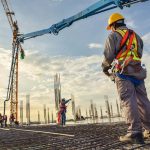Expansion joints are utilized for various vital architectural structures that particularly have a need of these joints. Buildings particularly high rise are exposed to various factors like weather, velocity, seismic activity, etc.
An expansion joint is an assembly that is designed to absorb safely expansion and contraction of different construction materials caused by heat. These joints also absorb vibration and permit movement due to earthquakes and ground settlement. They are mostly found between sections of bridges, sidewalks, piping structures, railway tracks, and other structures.
Concrete slabs, building faces, and pipelines contract and expand throughout the year because of the cooling and warming due to some heat resources and through seasonal variation. These joints can be used in paper, oil, and petrochemical industries and in various other fields. The variety of expansion joints present for application is wonderful. They are generally manufactured at the standard dimensions and can go from 1 to 200 inches in diameter. They can also withstand temperature from -300 degree Fahrenheit to 4000 degrees Fahrenheit at 2000 psig or vacuum.
The opening of the fabric expansion joints in the market thoroughly revolutionized the way that engineers solve corrosive, thermal expansion and abrasive problems. These joints can be utilized in various applications for turbines. With various designs and fabric membranes, extension joints may conveniently be utilized for turbine exhaust applications (GTX).
Here are few uses of expansion joint covers:




These need to be selected carefully because it is one of the crucial steps in specification process. Rolling load and the need of hygiene are some important considerations when selecting floor covers.
After choosing the cover for your floor, the next thing you need to focus on is the wall cover. It is a simple decision but when considering seismic joint covers there are plenty of options depending on the functionality and the aesthetics. There are several options like panel type joints to stainless steel covers; you can also find covers that can be easily detached from the wall to reduce the damage. You can even go with those that close on their own to reduce the post event maintenance.
Exterior walls of any building need to be durable so as to withstand even the worst of climatic conditions. Joints can be affected by shrinkage, heat, etc, so they must be chosen wisely. In buildings you can use vertical exterior seals made of thermoplastic whereas for big seismic walls you may make use of flush covers that provide zero sightline. Neoprene bellows with forced aluminum covers or with galvanized flanges can also be considered.
Parking garages need nicely installed roof joints and floor joints. Car parks are multi level buildings; therefore they need its floor joints to be in proper place so that cars do not slip of their parked position. Many floor expansion joints cover the fall off area to prevent the bolts holding them to fall off. Good quality covers that can take care of the center bolt are used here. Also stadiums have large floor spacing and roofs that need the building to be created in a secure manner.
Compression seals are the right option for the joint expansions as they deal with movements appropriately. They are required to be fitted in a place with water proof sealing and so it is vital that you make use of quality compression seals.
Winged seals are utilized in garages and stadiums where constant parking and wheeling of vehicles need no noising, no falling, and no garage closes for repairs that in turn save on your maintenance cost.


